Current Activity
Jim Chapple is now working full time on iphone/ipod touch and iPad applications.
Jim Chapple also works on Mac OS X Apps.
Please email Jim Chapple for support issues, information and quotes.
Forage
- Helps to identify wild foods that can be eaten. Each wild food has zoomable images to allow you to identify by sight as well as textual information that allows you to correctly identify the plant.
- Using the GPS this App can also record the location of the food you have just found so that you can find it again.
- Includes a search function to reduce the number of plants it could be so helping you to identify the plant.
The small thumbnail images below will show larger screenshots.


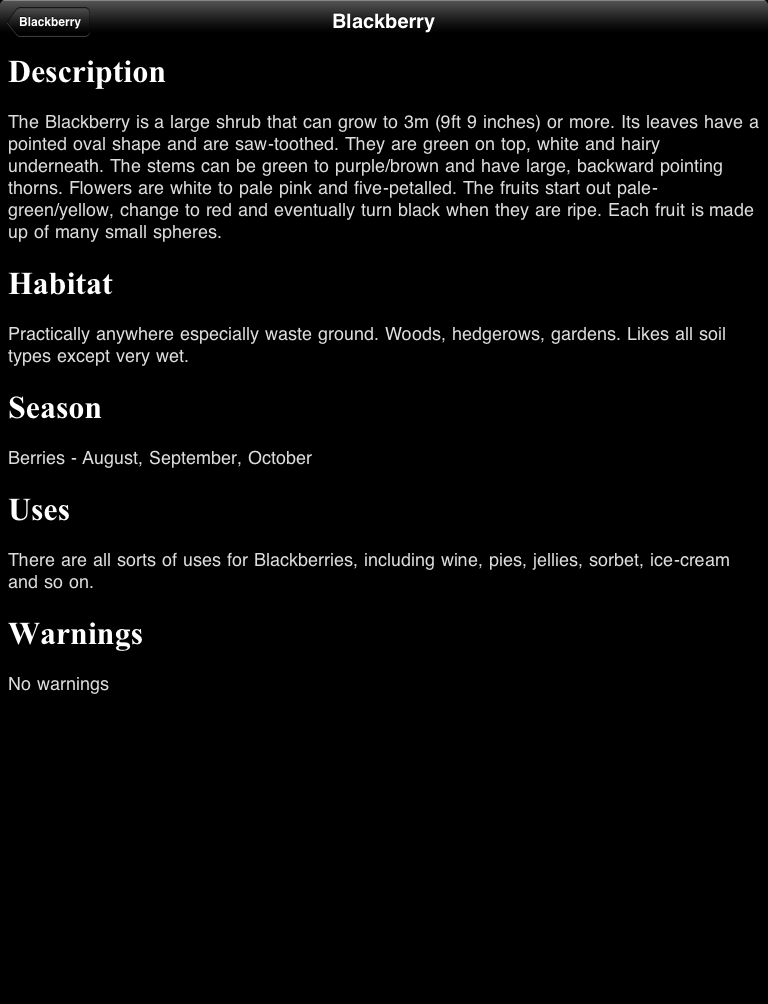
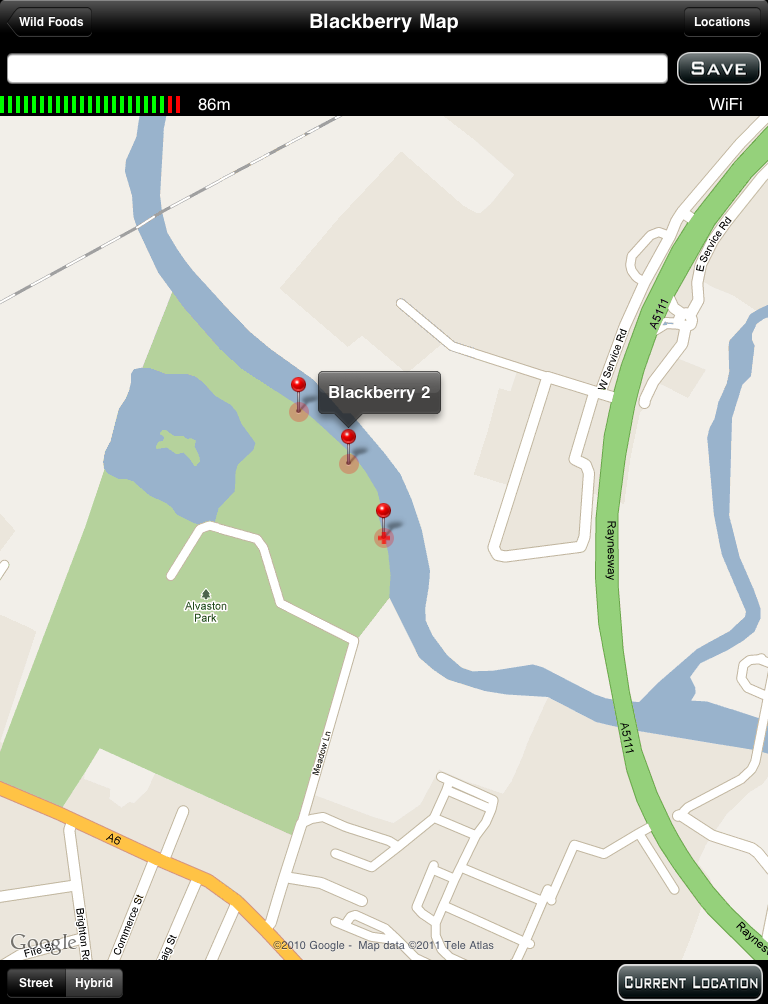

FAQ: This App does not work properly it keeps on crashing, why?
Sometimes Apps just do not download properly. You will need to download it again, for free, using itunes. See Apple Support Pages
About half way down the page there's a set of instructions that starts 'Reinstall the affected application'.
Once iTunes has it then you sync your device and it should then work. If it does not then please to contact me.

The food ListThe main page of the App. This page is a list of all of the foods included in the App. It is from here that all other functions are accessed. Select the blue details icon to access the information and images for each food type. Select a row in the table and then select 'Locations' to see the Map and all the locations you have recorded for that food type. Select 'Search' to access the search functions of the App. Search can be used to reduce this list of food to those that match the specific search criteria. So you can search for all foods with white five petalled flowers. This search would reduce the list of foods to eight and much more manageable list of foods to look through when trying to identify a plant. |
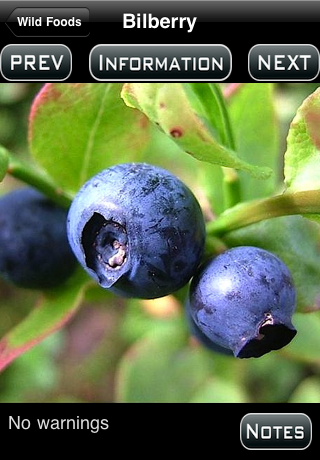
Food Details and ImagesThis page shows you all the information for the food you selected on the main page. This page shows you the images for the plant. You can zoom and move the images using the usual gestures. You can see other images for that food by using 'Prev' and 'Next'. To see the information for the food select the 'Information' button. This will take you to the textual information for the food. You can make your own notes for the food by selecting 'Notes'. In the bottom left corner is a small section that shows any warnings for a food. If there are warnings they will be shown here in red. These warnings are also repeated on the Information pages and are shown at the top just so you cannot miss them. |

Food InformationThis page specifies information about the plant and how to identify it. While some plants can be identified purely by sight there are plenty that cannot e.g. Sweet Cicely looks like a number of other plants so you may think you've found it but to be sure you have to rub the leaves and if they smell of aniseed then you have. It also has information about the plant's habitat, the season it grows, its uses and any warnings. |
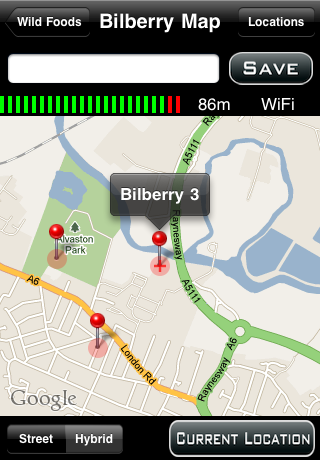
The Food MapSo you have found some free food now you need a way to record where it is for later use, next year, etc. Just go back to the main page select the food in the list and press 'Locations'. This is the Map page that shows you that specific food at your current location. You can move the map to any other location and see that food there. To save a food's location just wait until the GPS has accurately located it and press 'Save'. You do not have to even give it a name. If you don't one will be allocated or if you want to then just type the name into the field to the left of 'Save'. The accuracy of the GPS can be seen just above the map. The more green the bars the more accurate you have been located. The number next to the bars is the reported accuracy. You can move the location the GPS has specified to a more accurate location by just moving the red plus sign on the map. This red plus sign is the location recorded and not where the GPS says. The map when it loads will show you all that food's locations on the map. Select the pin to see the name of the location that has been saved. If you scroll the map away from you current location you can get back to it by selecting 'Current Location'. You can either see the street view of the map or you can select to see the hybrid view which is the satellite images overlaid with the street information. The 'Locations' button takes you to a table of all of the locations for that food. |
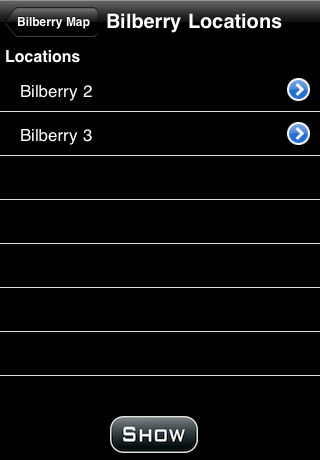
Food LocationsThis page shows you a table of all of the locations of the selected foods. If you want to see that location on the map then select the location in the table and then press the 'Show' button. The map page will be shown with that location in the center. You can make notes on each location by selecting the blue details icon. This takes you to the notes page for that location. |

SearchThe search function is there to enable you to narrow down the list of foods to those it could be given your search terms. Search is split into seven sections: Leaves, Flowers, Fruit/Berries/Nuts, Stems/Stalks/Branches, Seed Pods, Size, Roots/Bulbs. You can select as many or as few search terms as you see fit. Generally, just two or three will narrow the list of foods to less than 10. Using 'AND' rather than 'OR' will also narrow the search. Select 'Search' to perform the search using the criteria. The page will change back to the food list page. Hopefully there will only be a few foods to choose from. If there are none then you have used too many search terms or 'AND'. Trying using 'OR' to see if this works or remove a search term and try again. If you just want to reset back to the start to see all the foods then just select 'Reset All'. |
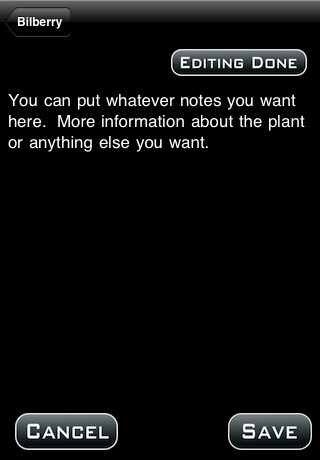
Food NotesYou can make your own notes on each food using this page. |

Food Location NotesYou can make notes on the food and its location on this page. Each note is specific to that location. You can also delete a location by selecting 'Delete'. |
